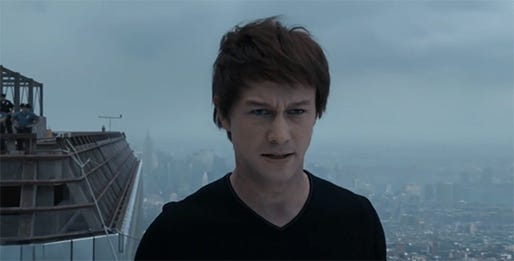The Walk

Although built for 3D thrills and busy with the business of a biopic, Robert Zemeckis’s “The Walk” shares a story with James Marsh’s sublime 2008 documentary “Man on Wire.” The Oscar-winning latter grafts taut suspense of just how the ebullient Frenchman Philippe Petit pulled off his 1974 wire-walk between the World Trade Center towers onto existential discussions of artistic achievement and true friendship.
Next to “Wire,” it seems impossible for “The Walk” to emerge as much besides something slick and slight. On its face, an immersive effects-driven, 3D-enhanced last act — in which Zemeckis persuasively puts us beside Petit 110 stories up — would be all to distinguish it from an also-ran retread.
Despite a wobbly start, “The Walk” eventually finds its feet once you realize Zemeckis and company are delivering a confident, charming and unexpectedly stirring version of the tale that’s aimed more at children than Marsh’s warts-and-all documentary. “The Walk” certainly bristles against its PG rating (tastefully bared buttocks, a nail through a foot, spoken and subtitled profanity), but there’s nary a mention of Petit’s promiscuous peccadilloes. And whenever its eccentricities threaten to erode your patience as a parent (or just an adult anticipating the superb spectacle) it wins you back — with a beautiful grace note of performance, a contextual consideration of New York and American culture, or Zemeckis’s latest indelibly iconic image of the improbable.
In that regard, Zemeckis acts here as Martin Scorsese did in “Hugo” — an old master pushing himself outside expectation to etch his own definition of extra-dimensional storytelling in the live-action realm. While it isn’t Zemeckis’s first foray into 3D, it is his best … and a finer film for kids than either of his horrifying Christmas-animation efforts.
Also as in “Hugo,” Ben Kingsley shows up here, playing Petit’s mentor, Papa Rudy. Amid Kingsley’s accent of indeterminate Eastern European enthusiasm, the word “consummate” becomes “con-summit” but he delivers a lovely, brief suggestion of paternal love for Petit … which the daredevil races on past.
Gordon-Levitt’s accent is also so thick it has a crust and butter spread on it. But that’s part of an outsized charm offensive to maintain kids’ attention before the prestige of a finish, and it also never undermines the commitment and charisma with which the actor balances bluster and bravado in Petit.
A sometimes black-and-white first act vibrantly equates Petit with Chaplin, Lloyd and Keaton as it explores his affinity for wire-walking — fostered at French circuses, furthered by an apprenticeship with Rudy and fully realized as Petit traverses the Notre-Dame Cathedral towers. On anything other than a large 3D screen, the pop-up storybook artifice of these scenes will certainly come off flimsy and cheap. (“The Walk” opens exclusively Wednesday in IMAX 3D theaters and everywhere on Oct. 9.)
But the tantalizing space between the under-construction World Trade Center towers beckons Petit from foreign shores. He must master these monoliths before they’re finished, as much to meet his aim to christen them with artistic meaning as it is to avoid full-blown security that would throttle his mission.
Aided by his girlfriend, Annie (Charlotte Le Bon), and a cabal of French and American cohorts (of whom only James Badge Dale’s Jean-Pierre — or J.P., as he’s anglicized it in New York — registers as much more than a warm body), Petit hatches a plan: Gather reconnaissance, collect the gear they need, reach the roof under false pretenses, securely string the wire and stay undetected until dawn when he can unleash his “beautiful show” for the masses below.
This middle hour morphs into a bustling “Mission: Impossible” for the munchkin set — Alan Silvestri’s score sparking to life with flamboyant auxiliary percussion flourishes pitched at the jittering accelerando of Petit’s mind. Like a satyr transformed into a full-blown man, Levitt bottles Petit’s perpetually bobbling buoyancy. But he lets just enough stubbornness and insecurity escape the veneer of this confident showman. For all his ingratiating mile-a-minute babbling, Levitt hardens his face and zips his lips for a late moment in which, under threat of discovery, we feel recalcitrance violently race through his veins. And he transforms what seems like a prima donna costume mishap rant into a revelation: A turtleneck lost to the void below is necessary … as armor against his own apprehension about stepping on the wire.
Once he takes that first step, “The Walk” embraces a majestic, meditative quality masterfully realized in Zemeckis’s playful-craftsman style. Petit’s impishness fades away into just breathing and being. (It helps that Levitt’s Zen calm comes from clear performance of his own wire-walking 12 feet up — a pants-filling proposition for most of us, let alone what Petit accomplished.) Unless you’re deeply afraid of heights, the ethereal, otherworldly infinity of the walk itself is terrifying only for a moment before it softens into a marvel. Like Petit, we realize this rarefied air is thinner, but purer, and should be savored as such.
“The Walk” focuses on the tenacity of Petit and his team, nearly to the point where it sometimes feels like a sports film. Even if it stumbles in its earlier attempts at poetry, it’s a film that leaves audiences of any age poignantly pondering many unexpected ideas — the sanctity of space an artist inhabits on the stage and in his own head, a scene of creative stigmata for those giving of their safety for our entertainment, the resilience and rewards of problem-solving, the contributions of immigrants on whose back the “American” dream was born, the idea of imbuing a slab of steel with a soul all its own. Plus, paired with an infinitesimal quiver in Levitt’s last word, the final image achieves a tastefully evocative power.
Although its cartoonish qualities sometimes belie its confidence, “The Walk” certainly stands on its own as a crowd-pleasing complement to “Man on Wire.”


